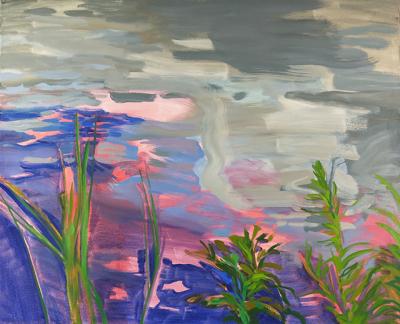Opinion: Landscapes Real and Imagined in Amagansett

The three-person show at Amagansett’s Ille Arts Gallery has a unifying theme in landscape painting, but the path each artist follows in addressing it diverges wildly. What is fascinating, though, is how each section of the show manages to have something to say to the others. It becomes a show that is by turns literal, figurative, abstract, and highly individualized.
The artists involved are Kamilla Talbot, Barbara Thomas, and Matthew Vega. Each works in oil, but achieves different tones, finishes, compositions, and densities in that medium.
Ms. Talbot chooses a high-keyed palette, but the finish is flat — not quite matte, but no sheen in sight. This is the right choice for the deep pinks, electric blues and greens, and showy yellows in her abstracted compositions of Expressionistic color.
Her intention is to examine various water bodies in relation to their edge, be it delineated by land or the bounds of a man-made vessel. It’s the point where earth or wood or fiberglass gives way to shimmery depth, movement, reflection, and transparency. It might be a Catskill pond or a shoreline, but her water bodies absorb and give back all the light and color of the surrounding landscape as well as the sky. They are both dreamy and honest depictions of a very personal apprehension of nature.
Her saturated colors come close to veering off into garishness, but never quite get there, and there is something exhilarating about her graceful dance to keep it all in check. One more brushstroke and each canvas could veer past the point of poetry and into the realm of mawkishness.
In Ms. Thomas’s series “The Day,” we have 24 paintings, all oil on board, which take us from dawn to dusk and beyond. The exhibition encompasses the 16-by-24-inch paintings as well as postcard-size studies on paper, along with a video of these compositions that allows them some movement to imply time’s passage.
It is a sumptuous installation. Even though the pieces ultimately will be broken up through their individual sale, the whole is indeed greater than its parts.
Rather than keep the enterprise a purely literal examination, Ms. Thomas reaches for the poetic in her titles, evoking mystery and the connection of nature to our subconscious, and even a bit of heaven. “Great Is the Sun and Wide He Goes,” “All Is Blue and Strange,” “Wet Dawn Inks Doing Their Blue Mirage,” and “I Have Been One Acquainted With the Light” are a few examples.
The colors, too, are just past the realm of nature’s palette. She has chosen to heighten them with a touch of florescence, lending a sense of the surreal. It is most evident in her grass, which, amazingly, appears both generalized and specific. A wide, low swath of green is cut into with tiny lines to create individual blades. Her clouds are both dense and cottony and thin and gauzy, sometimes in the same composition. Her sunset subjects might be pale offerings or deeply hued extravaganzas of reds, purples, oranges, and yellows. Suddenly all is dark, but then the sky reignites with the rising of the moon, only to be diminished by the gathering clouds.
Artists have been coming up with ways to mark the passage of time and its implications for our mortality for centuries, with classic traditions such as vanitas or memento mori paintings. Rather than a grand, sweeping gesture, Ms. Thomas gives us a tiny morsel, one that evokes such themes but allows us the chance to dismiss them on such a fine “day.”
Mr. Vega’s work, on the other hand, does something else entirely. His approach takes the conceptual nature of the other artists a step or two beyond. His paintings are memories not of actual landscapes he has seen, but his recollection of landscape paintings. This approach, completely removed from reality, casts him as interpreter of the interpreted. He said it was an attempt to tap into a perhaps universal memory or collective unconscious of art history. Only one of this series is included in the show, and it is in the gallery office. The rest of the exhibition is his "Dimorphism" series.
In these, the artist said he is dealing with "forms, organisms perhaps, which are related yet different, and the possibility of how those forms interact with one another as a result of, or in fact because of, those differences." Not wholly abstract, the paintings could even refer to simple cellular organisms. From the bivalent objects depicted to the dual nature of his presentation, he leaves us with much to ponder.
The exhibition remains on view through Monday.
An earlier version of this review unintentionally blended and examined Mr. Vega's two series together. The "Dimorphism" series and the "Memory Landscape" series are two distinct bodies of work.
